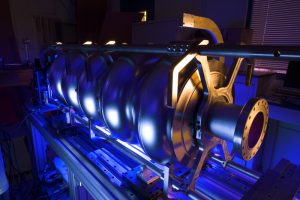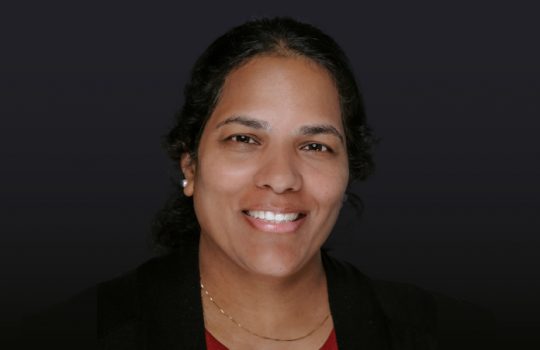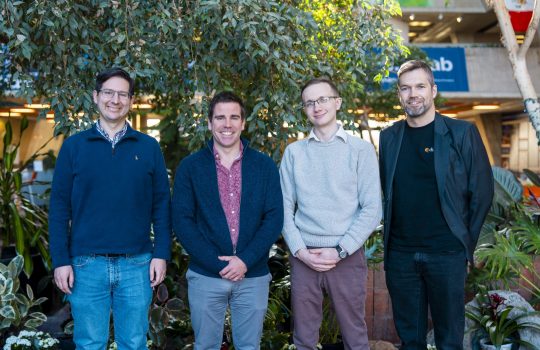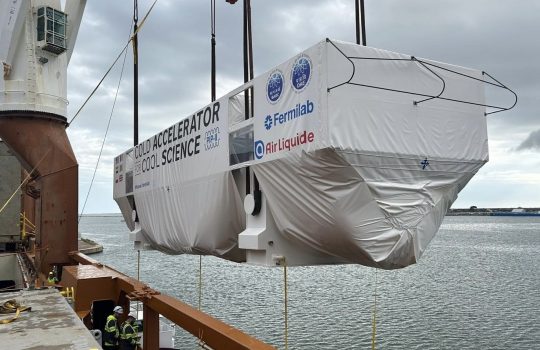
Fermilab is contributing to accelerator programs at Northern Illinois University and the University of Chicago. The aim of these programs is to improve particle beam delivery, including the performance of superconducting radio-frequency technology. Photo: Reidar Hahn
Particle accelerators shape our everyday lives. They are powerful tools in medical diagnosis and treatment. They were used to develop materials in everything from your cell phone screen to the chips in your computer. They even help us explore the fundamental particles and forces that make up the world around us. Until 2014, the National Science Foundation did not have a program funding fundamental R&D on accelerator science. This year marks the second year of this newly initiated program.
This year, the NSF is awarding grants to fund research on the development of bright beams at the University of Chicago and Northern Illinois University at a level of $680,000 and $560,000, respectively, for a three-year period. In both programs, Fermilab will play an integral role in exploring and pushing the limits of accelerator science.
The University of Chicago proposal, titled “Innovations in Bright Beam Science,” calls for the development of a program to make high-powered, stable beams with low losses. It comprises three themes: studying superconducting radio-frequency cavities; conducting a proof-of-principle experiment with circular accelerators to investigate ways to produce more stable beams; and exploring techniques to produce more intense X-rays. The first two of these are parts of a bigger R&D program at Fermilab, including the superconducting radio-frequency program and the Integrable Optics Test Accelerator.
This will be the first time the University of Chicago will assemble a group working on an accelerator program. Beyond improving accelerator technology, one of the goals of the program is to attract faculty members and students to accelerator research.
“The benefit from this is that we bring in chemistry and mathematics professors who would never otherwise be exposed to our research,” said Fermilab Accelerator Division Head Sergei Nagaitsev. “This is an opportunity for us to collaborate with colleagues who ordinarily don’t collaborate with Fermilab.”
The NIU proposal is called “Development of Ultra-cold Quantum-degenerate Relativistic Electron Beams for Research and Applications.” The NSF-funded research at NIU will address the question of whether they can produce a beam a thousand times cooler in temperature than existing beams, resulting in higher beam brightness and quality.
“Everybody’s trying to get to high energies, beam powers and intensities quickly, but nobody is working on producing high-quality, ultracold beams like these,” said Swapan Chattopadhyay, principal investigator of the NSF-funded project at NIU. “No matter what you do with a beam, you can not do any better than the intrinsic goodness of the beams. We’re working on producing beams not only of high energy and intensity, but also of very good purity and quality.”
The researchers, physicists and engineers aim to produce electron beams from specially designed nanocathodes immersed in high electric fields, packing and focusing the electrons tightly. The beams will be cold enough to serve as a source for high-quality compact X-ray lasers.
NIU will carry out the experimental work at Argonne National Laboratory and Fermilab and plans to collaborate with Cambridge University Graphene Center.
With Fermilab’s infrastructure and expertise in accelerator science and technology, the laboratory will offer a place to test and expand the ideas developed throughout the research, while the universities will have the capability and time to delve deep into a problem. The proposals emphasize student training and education and will give Fermilab access to high-caliber graduate students at the University of Chicago and NIU.
“The university brings the academic depth and focus,” Chattopadhyay said. “Fermilab brings national expertise, infrastructure and a breadth of skills and resources, and by collaborating with industry, we will also get a practical perspective.”
Although NIU and the University of Chicago are focusing their efforts on different issues, they share the goal of creating accelerators that are more powerful than the ones currently in use. The two are very complementary, Chattopadhyay said, and he hopes they can collaborate to create something that is larger than the sum of its parts.
“These are scientifically very exciting questions,” said Young-Kee Kim, lead of the University of Chicago research program. “We continue to push our technology to get better accelerators with brighter beams, but there are a lot of limits we have to overcome. That limit can be overcome only by understanding all these issues and limitations at a very fundamental level.”



